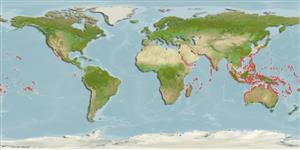Common names from other countries
Environment: milieu / climate zone / depth range / distribution range
Ecologia
Associadas(os) a recifes; intervalo de profundidade 0 - 10 m (Ref. 96667). Tropical
Indo-Pacific: from East Africa to French Polynesia.
Length at first maturity / Tamanho / Peso / Idade
Maturity: Lm ? range ? - ? cm Max length : 10.0 cm CL macho/indeterminado; (Ref. 128968)
The carapace has protruding frontal borders which are divided into four lobes (first three are rounded and the fourth is tooth-like. The body is covered with eye-like chocolate brown spots and smooth, well-defined lobules. Both front pincers are of the same size, while the walking legs are fringed with long hairs (Ref. 128968).
Adults occur in coral reefs, hidden under rocks during the day. Nocturnal (Ref. 128968). The shell and flesh of this species contain neosaxitoxin, saxitoxin, and tetrodotoxin (Ref. 107779, 128965) which have been proven to be fatal when ingested (Ref. 128965).
Life cycle and mating behavior
Maturidade | Reprodução | Desova | Ovos | Fecundidade | Larvas
Members of the order Decapoda are mostly gonochoric. Mating behavior: Precopulatory courtship ritual is common (through olfactory and tactile cues); usually indirect sperm transfer.
MarineSpecies.org. 2050. (Ref. 3477)
Categoria na Lista Vermelha da IUCN (Ref. 130435: Version 2024-1)
Categoria CITES (Ref. 108899)
Not Evaluated
Not Evaluated
Ameaça para o homem
Poisonous to eat (Ref. 107779)
Utilização humana
Pescarias: espécies comerciais
| FishSource | Sea Around Us
Ferramentas
Mais informação
Idade/TamanhoCrescimentoComprimento-pesoComprimento-comprimentoMorfologiaLarvasAbundância
Fontes da internet
Estimates based on models
Preferred temperature
(Ref.
115969): 24.6 - 29.3, mean 28.3 (based on 3236 cells).
Vulnerabilidade
Low vulnerability (10 of 100).
Categoria de preço
Unknown.
